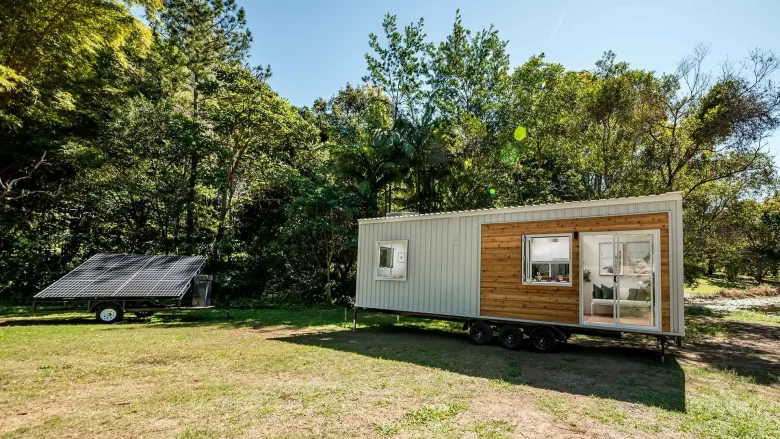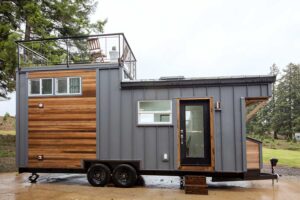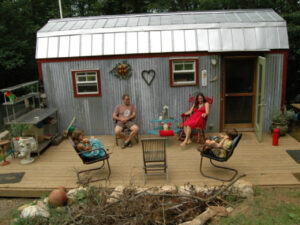In a world full of waste and consumerism, more and more people are looking for a different way of life that values simplicity, sustainability, and a lower impact on the environment. The off-grid micro-living movement has been accelerated by people wanting to get off the grid and live in harmony with nature. People who choose this lifestyle often live in small, simple spaces and rely on renewable energy and eco-friendly habits. This article discusses off-grid microliving. It discusses why it is so popular, what problems it can cause, and how it can help you live a more sustainable and fulfilling life.
1. The Allure of Tiny Living:
Small-scale off-grid living is attractive because it allows you to escape the constraints of consumer culture. Many people like to cut back on spending to make life easier and focus on the important things. Living in a small house, which is typically between 100 and 500 square feet, people appreciate the experience of things. When people understand that they can live a fulfilling life with less money, this change in perspective makes them more focused and satisfied.
2. Impact on the Environment:
One of the main reasons why people choose to live in small houses off the grid is the lower impact on the environment. Small homes typically use fewer resources to build and maintain, meaning they leave a smaller carbon footprint. In addition, many small house owners choose eco-friendly materials and sustainable construction methods. As a bonus, using renewable energy sources such as solar panels and composting toilets not only makes living space smaller but is also good for the environment.
3. Challenges of Off-Grid Tiny Living:
While living off the grid in a tiny house is appealing, it also comes with its own set of problems. People who live in small spaces have to be very picky about what they keep, which forces them to adopt a minimalist mindset. Additionally, the lack of communal facilities such as large kitchens and bathrooms can be a big change for people who are used to living in larger spaces. People living off the grid also need to be more involved in maintenance and troubleshooting, as they are often responsible for their own water supply, waste disposal, and energy generation.
4. Control Your Energy:
One of the main ideas behind living in a small house, off-the-grid, is to source as much energy as possible yourself. Small homes are ideal for solar energy because of their lower energy needs. To meet these needs, photovoltaic panels can be used. LED lighting and appliances that use less energy also help reduce power consumption. Off-grid living encourages people to be more responsible with their energy consumption, resulting in a closer connection to the environment and a greater appreciation for eco-friendly practices.
5. Pay Attention to Water Sources:
Providing water in an off-grid tiny house is very important and requires careful planning. Many small homeowners use composting toilets, rainwater collection systems, and gray water recycling to reduce water use. These actions not only protect valuable resources but also demonstrate the importance of managing water well in an increasingly water-scarce world.
6. Community and Connections:
Living small, off the grid, can create a strong sense of community, despite the perception that it can make people feel lonely. There are now small house villages and intentional communities where people with similar goals live together and share resources, skills, and desire to live in a way that does not harm the environment. This sense of connection extends beyond the walls of the tiny house, creating a support network that improves the health of everyone within the community.
Conclusion
Off-grid microliving is very different from a normal lifestyle. It helps you become more eco-friendly, simpler, and more connected to nature. While there are challenges, the rewards are enormous, both for you and the environment. The movement continues to grow as more and more people try this different lifestyle. It inspires others to rethink their relationship with the environment and embrace a more purposeful, fulfilling life. Off-the-grid living in a tiny house is a sign of hope for a peaceful, eco-friendly future. It shows that less can indeed be more.
FAQs
1. What does ‘off-grid living’ mean?
Living in a small, often portable home without being connected to traditional utilities such as water, electricity, and sewer is known as ‘off-grid micro-living’. It emphasizes sustainability, simplicity, and low environmental impact.
2. What attracts people to living in tiny off-grid homes?
People are interested in off-grid microliving for various reasons, such as the desire to simplify their lives, reduce their impact on the environment, and appreciate the experience of things. People are moving away from consumer culture and towards a more conscious and eco-friendly lifestyle.
3. Why is living off the grid in a tiny house good for the environment?
Small homes typically use fewer resources to build and maintain, leaving a smaller carbon footprint. Many tiny homeowners also choose eco-friendly materials and add renewable energy sources such as solar panels to make their homes more eco-friendly.
4. What problems do you face when living in a small house that is not connected to the electricity grid?
One problem was that there wasn’t much space, so items had to be kept to a minimum and smaller areas such as the kitchen and bathroom had to be changed. Off-grid living also requires more hands-on maintenance, as residents are responsible for collecting water, disposing of waste, and generating electricity.
5. How can an off-grid tiny house get its electricity?
Solar panels often allow small, off-grid homes to get their power, using only the small amount of power they need. Energy-efficient appliances and LED lighting use even less electricity, making it easier for people to monitor and monitor their electricity consumption.
6. How do you treat water in a small house that is not connected to the electricity grid?
Some ways that small off-grid homes can manage water are by collecting rainwater, recycling gray water, and using toilets that break down organic matter. These technologies help reduce water use, conserve resources, and support good water management.



